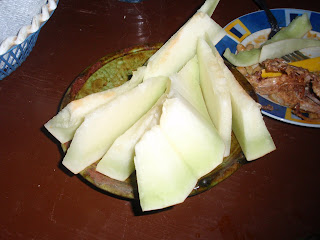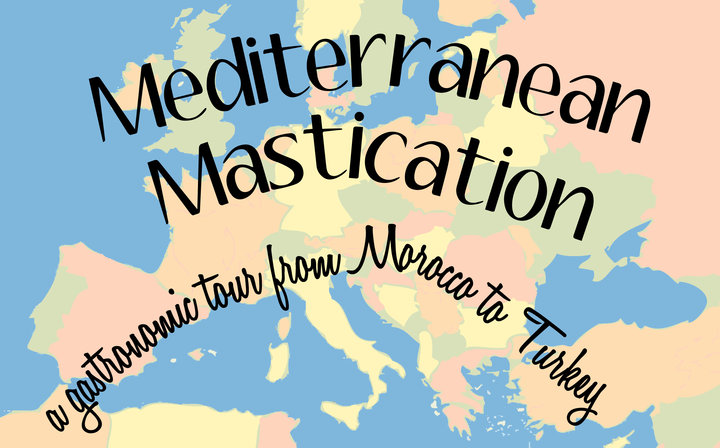You will be glad to know I have been doing some solid Moroccan masticating research over the past week, so here are some of the fruits of my labour. Moroccan cooking is influenced by four culinary traditions. The food of the North African Berber and Arab nomads forms the basis. Added to that are recipes derived from the oriental Jewish tradition from Andalusia (southern Spain) and finally French cuisine.
Moroccans generally start the day with a good dosage of rocket fuel coffee which can be described as somewhat like espresso on crack (i.e. strong!). This is usually accompanied with a cup of hot milk for you to add as you please and no less than 4 sugar cubes with a side dish of sugar. They sure do love their sugar. Sugar sachets are the equivalent of at least 2-3 teaspoons and it is not uncommon to use more than one for a morning coffee.
 Yes 5 sugar cubes IS necessary!
Yes 5 sugar cubes IS necessary!Fresh OJ is plentiful, cold, delicious, refreshing and everywhere… sides of the road, cafes, markets - fresh OJ is the bomb.


Although Morocco declared independence from France in 1956, the French influence is still strong and noticeable within Moroccan cuisine. Sweet croissants and bread (usually baguette, but also fried traditional flatbread in more rural areas) complete the breakfast meal, accompanied by butter and marmalade (mmmmm more sugar). Boiled eggs & laughing cow (French branded) cheese are also infrequently available.

Lunch is generally the larger meal of the day, however in interests of my culinary explorations I have also been doing some solid dinner investigations. No need to thank me.
All meals are commenced with bread, local olives (salty & spiced; both green & black varieties), legumes/lentils and often marinated vegetables (carrot, cucumber).

Hairira is also commonly served before the main meal – a thick soup of lentils, chickpeas, flour, rice & onions (with or without meat).

Tagines are synonymous with Moroccan cuisine and two of the more common combinations are chicken with preserved lemon & green olives and lamb with prunes, although many more varieties exist. Tagine is actually the name of the pot with the conical lid in which the meal is cooked & served in – a form of slow cooking the stew over a low heat (either flame or coals) which produces incredibly tender meats. Tagines are usually flavoured with the help of ras el hanout (mixture of up to 25 spices including cumin, paprika, saffron, cinnamon & ginger) and the sauces also frequently include sweet plums, raisins & olives.
 Chicken tagine with vegetables (including potato, peas, carrot and green olive)
Chicken tagine with vegetables (including potato, peas, carrot and green olive) Lamb tagine with prunes
Lamb tagine with prunesAnother national dish is of course cous cous, the fine semolina grain served topped with vegetables and legumes (regularly zucchini, carrot, broad beans). Meat of your choice can also be added. Cous cous is served with the spiced broth the vegetables were cooked in for you to ladle as required for when the cous cous grain is dry. It is also served with the hot & spicy chili paste also known as harissa to give it a bit of a kick.
 Cous cous with chicken and legumes (vegetables)
Cous cous with chicken and legumes (vegetables)In terms of the meat hierarchy in Morocco horse and camel are considered delicacies, followed by lamb, beef & chicken. Pork is not served as Islam forbids its consumption.

Camel consists of a slightly fattier cut of meat and not too dissimilar in taste to beef. Camel can be served minced & heavily spiced as a burger in a bread roll with grilled tomato & onion.

Kefta (strongly spiced beef meatballs cooked in hot oil) sandwiches and tagines are also popular, served with egg in the tagine form.
 Kefta with frittes.
Kefta with frittes.Another Moroccan specialty is Bstella aka Pastilla, served on special occasion as a main although it is quite sweet. Layers of puff pastry filled with chicken meat (traditionally pigeon was used) with a mixture of almond paste, onion puree & scrambled eggs. Spices including ginger, cinnamon, coriander, salt, pepper & saffron are included and the dish is finished with a dusting of powdered sugar. Might sound a bit strange but is delicious, and means you don’t have to have dessert as well!

Desserts feature the multitude of fresh fruits (especially a sweeter cousin to the honeydew melon), as well as crème caramel (another kickback to the days of French rule). Locally made pastries are also ever popular in the local marchés and with variety galore, however one of the most common is the gazelle’s horns, sweet crescent shaped pastry, filled with almond paste & dusted with powdered sugar.

 Gazelles on right underneath the golden samosa-looking thing.
Gazelles on right underneath the golden samosa-looking thing.Although alcohol is not part of the Muslim beliefs, the most common beverage in Morocco is ‘Moroccan whiskey’ aka tea de menthe (green tea with fresh mint), named for its similar colour to the dark malted liquor. No meal, snack, introduction, carpet selling attempt, toilet stop... well really any kind of break in the day is without a glass of hot sugary (surprise surprise!) mint tea. Moroccans generally have no less than 9 cups a day, and the tea pouring ceremony is usually part of the attraction with bulging English style teapots & small coloured tea glasses, often cut with a gold rim.


I have also managed to sample a few locally produced beers, Flag Speciale being the VB/Carlton Draught standard, Casablanca beer similar to a lager, however both are somewhat sweeter than international beers.


As I’m sure you have picked up on, sugar is a large part of the Moroccan cuisine, & that paired with a somewhat casual (or non-existent) attitude to regular dental hygiene is a recipe for some interesting looking chops. Throughout the cities, especially in the ancient medinas, signs advertising ‘Dentiste’ are everywhere. However most are family-trained ‘mechanical’ dentists, skilled only in the removal of rotten teeth. All that sugar has got to go somewhere I guess.

Hopefully this installment has caused some salivation – I am currently en route from the Sahara to the High Atlas Mountains and heading towards the coast in the next few days, so no doubt you can expect to see some seafood dishes in the near future.
Until then, keep masticating. x

Court, loving your exploits.
ReplyDeletejust the sort of travelling i always do-food being no. 1 rea
son to go anywhere!!!
have had some good eating ourselves, lately, just not as exotic as yours.keep well, love liz cinatl
i hope your using your special fancy colourful camera too. The food looks yum- your doing very very thorough research. xx
ReplyDelete